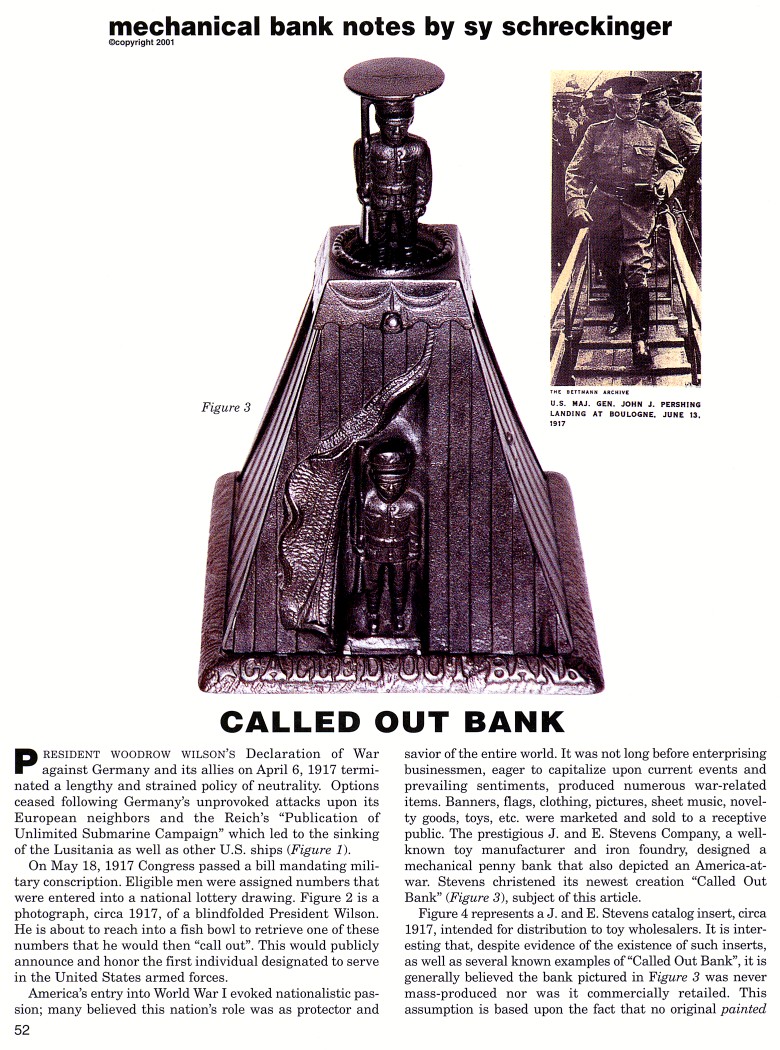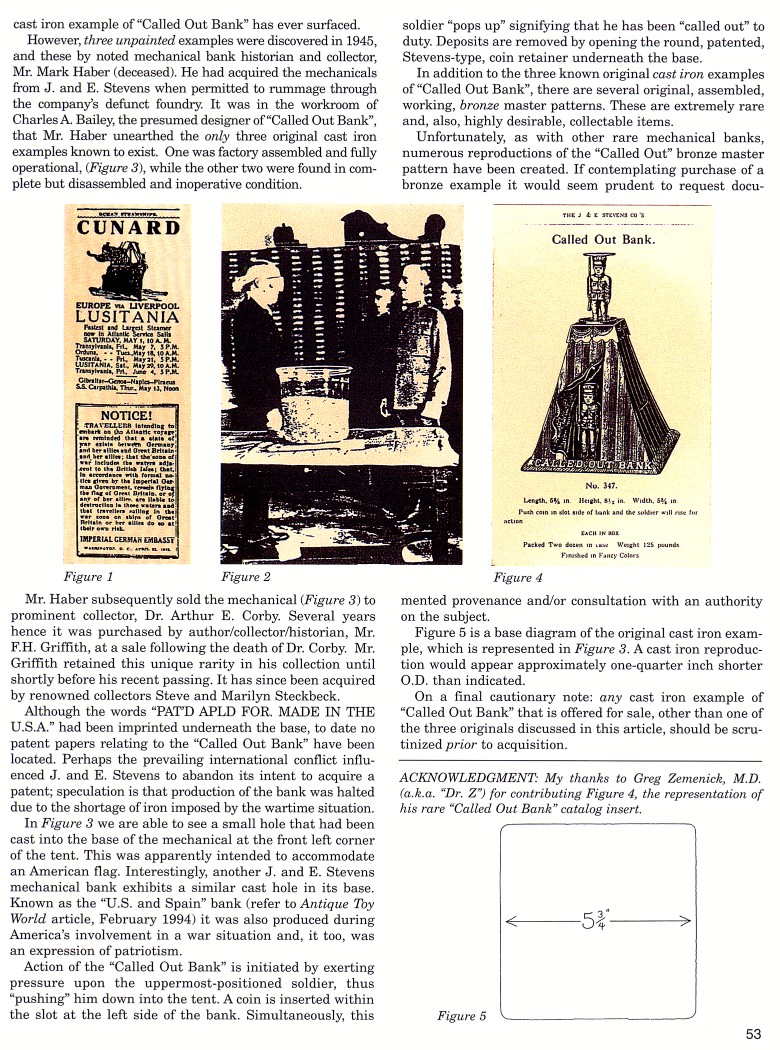|
Called Out
Bank
by Sy Schreckinger – ANTIQUE TOY WORLD Magazine – May, 2001
President Woodrow Wilson’s Declaration of War
against Germany and its allies on April 6, 1917 terminated a lengthy and
strained policy of neutrality. Options ceased following Germany's
unprovoked attacks upon its European neighbors and the Reich's
"Publication of Unlimited Submarine Campaign" which led to the sinking of
the Lusitania as well as other U.S. ships (Figure 1).
On May 18, 1917 Congress passed a bill mandating military
conscription. Eligible men were assigned numbers that were entered into a
national lottery drawing. Figure 2 is a photograph, circa 1917, of a
blindfolded President Wilson. He is about to reach into a fish bowl to
retrieve one of these numbers that he would then "call out". This would
publicly announce and honor the first individual designated to serve in
the United States armed forces.
America's entry into World War I evoked nationalistic passion; many
believed this nation's role was as protector and savior of the entire
world. It was not long before enterprising businessmen, eager to
capitalize upon current events and prevailing sentiments, produced
numerous war-related items. Banners, flags, clothing, pictures, sheet
music, novelty goods, toys, etc. were marketed and sold to a receptive
public. The prestigious J. and E. Stevens Company, a well- known toy
manufacturer and iron foundry, designed a mechanical penny bank that also
depicted an America-at-war. Stevens christened its newest creation "Called
Out Bank" (Figure 3), subject of this article.
Figure 4 represents a J. and E. Stevens catalog insert, circa 1917,
intended for distribution to toy wholesalers. It is interesting that,
despite evidence of the existence of such inserts, as well as several
known examples of "Called Out Bank", it is generally believed the bank
pictured in Figure 3 was never mass-produced nor was it commercially
retailed. This assumption is based upon the fact that no original painted
cast iron example of "Called Out Bank" has ever surfaced.
However, three unpainted examples were discovered in 1945, and these
by noted mechanical bank historian and collector, Mr. Mark Haber
(deceased). He had acquired the mechanicals from J. and E. Stevens when
permitted to rummage through the company's defunct foundry. It was in the
workroom of Charles A. Bailey, the presumed designer of "Called Out Bank",
that Mr. Haber unearthed the only three original cast iron examples known
to exist. One was factory assembled and fully operational, (Figure 3),
while the other two were found in complete but disassembled and
inoperative condition.
Mr. Haber subsequently sold the mechanical (Figure 3) to prominent
collector, Dr. Arthur E. Corby. Several years hence it was purchased by
author/collector/historian, Mr. F.H. Griffith, at a sale following the
death of Dr. Corby. Mr. Griffith retained this unique rarity in his
collection until shortly before his recent passing. It has since been
acquired by renowned collectors Steve and Marilyn Steckbeck.
Although the words "PAT'D APLD FOR. MADE IN THE U.S.A." had been
imprinted underneath the base, to date no patent papers relating to the
"Called Out Bank" have been located. Perhaps the prevailing international
conflict influenced J. and E. Stevens to abandon its intent to acquire a
patent; speculation is that production of the bank was halted due to the
shortage of iron imposed by the wartime situation. In Figure 3 we are able
to see a small hole that had been cast into the base of the mechanical at
the front left corner of the tent. This was apparently intended to
accommodate an American flag. Interestingly, another J. and E. Stevens
mechanical bank exhibits a similar cast hole in its base. Known as the
"U.S. and Spain" bank (refer to Antique Toy World article,
February 1994)
it was also produced during America's involvement in a war situation and,
it too, was an expression of patriotism.
Action of the "Called Out Bank" is initiated by exerting pressure
upon the uppermost-positioned soldier, thus "pushing" him down into the
tent. A coin is inserted within the slot at the left side of the bank.
Simultaneously, this soldier "pops up" signifying that he has been "called
out" to duty. Deposits are removed by opening the round, patented,
Stevens-type, coin retainer underneath the base.
In addition to the three known original cast iron examples of "Called
Out Bank", there are several original, assembled, working, bronze master
patterns. These are extremely rare and, also, highly desirable,
collectable items.
Unfortunately, as with other rare mechanical banks, numerous
reproductions of the "Called Out" bronze master pattern have been created.
If contemplating purchase of a bronze example it would seem prudent to
request documented provenance and/or consultation with an authority on the
subject.
Figure 5 is a base diagram of the original cast iron example, which
is represented in Figure 3. A cast iron reproduction would appear
approximately one-quarter inch shorter O.D. than indicated.
On a final cautionary note: any cast iron example of "Called Out
Bank" that is offered for sale, other than one of the three originals
discussed in this article, should be scrutinized prior to acquisition.
ACKNOWLEDGMENT: My thanks to Greg Zemenick, M.D. (a.k.a. "Dr. Z") for
contributing Figure 4, the representation of his rare "Called Out Bank"
catalog insert.
|


